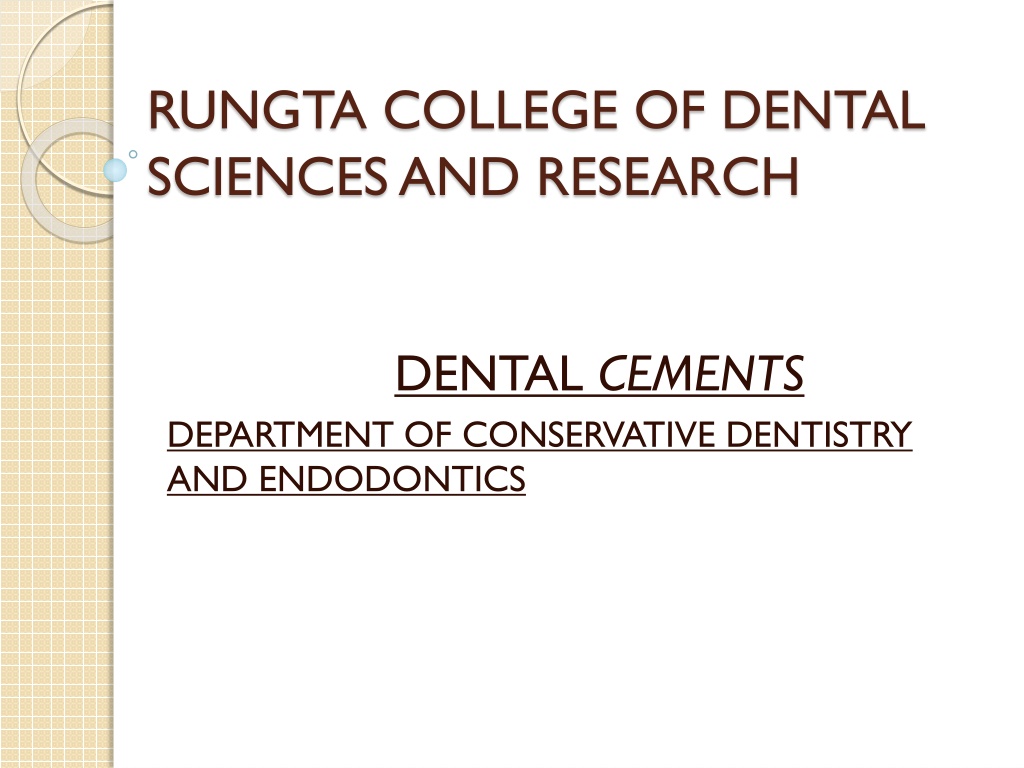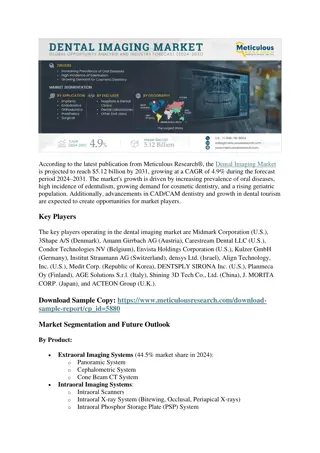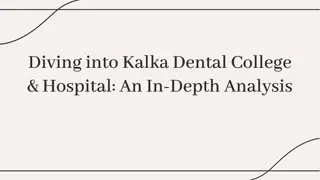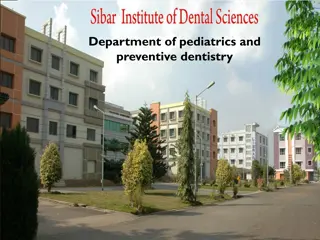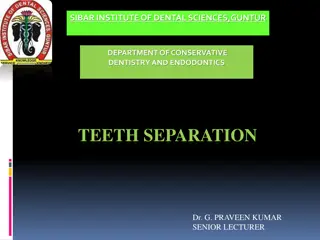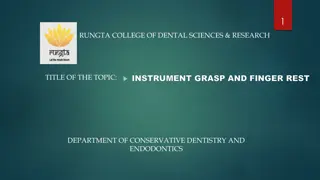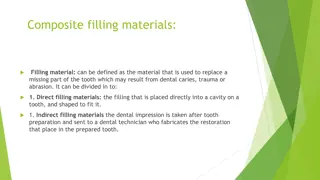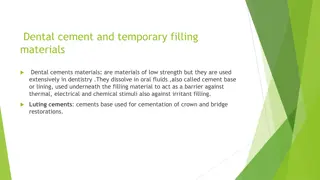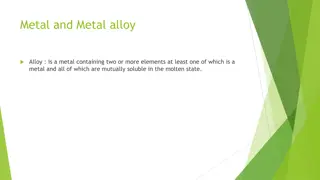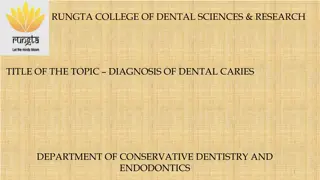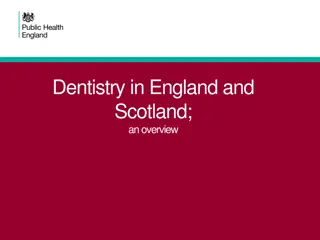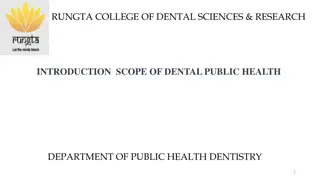Dental Cements in Conservative Dentistry and Endodontics
Learn about various types of dental cements used in conservative dentistry and endodontics, including zinc silicophosphate, resin cements, copper cement, and zinc oxide-eugenol cement. Understand their compositions, properties, classifications, and ideal requirements for different dental applications. Explore specific learning objectives related to these dental materials.
Download Presentation

Please find below an Image/Link to download the presentation.
The content on the website is provided AS IS for your information and personal use only. It may not be sold, licensed, or shared on other websites without obtaining consent from the author. Download presentation by click this link. If you encounter any issues during the download, it is possible that the publisher has removed the file from their server.
E N D
Presentation Transcript
RUNGTA COLLEGE OF DENTAL SCIENCES AND RESEARCH DENTAL CEMENTS DEPARTMENT OF CONSERVATIVE DENTISTRY AND ENDODONTICS
Specific learning objectives at the end of this presentation the learner is expected to know ; Core areas* Introduction classification Compositions Domain ** Cognitive Cognitive Cognitive Category # Must know Must know Must know
Contents Introduction Key terms Agents for pulp protection Ideal requirements Classifications Properties composition
Zinc silicophosphate cement Has resulted from combination of zinc phosphate cement & silicate powders A.D.A. specification -21 Type 1 cementing medium Type 2-temporary posterior filling material Type 3- both uses Anticariogenic due to Fl release High compressive strength- 165 Mpa. Semitransluscency Uses-luting agent intermediate restorations As a die material.
Resin cements They are filled & unfilled resins Supply powder & liquid system - two paste system Setting 4-10 min reaction chemical [ peroxide amine induction ] -light activation Enamel bonding by acid etch Dentin bonding by dentin bonding agents Irritant to pulp Insoluble in oral fluids Use cementation of porcelain veneers ,crowns& bridges
Copper cement Copper oxide ,[cuprous red, cupric black] Zinc oxide they are bacteriostatic & bactericidal irritant to pulp-Ph 5.3 USES: Temporary fillings in children Inermediate restorations
Zinc Oxide- Eugenol Cement These cements have been used extensively since-1890 s. In general ,they are cements of low strength. Depending on their use they vary widely in their properties. Least irritating of all dental cements. Known to have Obtundant effect on exposed dentin.
Classification:- According to ADA specification no-30 Type I- For temporary cementation Type II- For permanent cementation Type III- Temporary filling material and thermal insulation Type IV- Cavity liners. Mode of supply:- It is available in two forms 1. Powder and Liquid 2. Two paste system
Composition Powder Zinc oxide- 69.0% Principal ingredient. White rosin- 29.3% to reduce brittleness of set cement. Zinc Stearate- 1.0% Accelerator, Plasticizer Zinc acetate- 0.7% Accelerator, improves strength. Magnesium oxide- is added in some powder. it acts with eugenol in similar manners as zinc oxide.
Liquid:- Eugenol- Reacts with zinc oxide Olive oil- Plasticizer Setting Reaction:- When the powder and liquid are mixed In the first phase of reaction hydrolysis of zinc oxide to its hydroxide takes place Water is essential for the reaction to proceed. The reaction proceeds as a typical acid-base reaction to form a chelate. The chelate forms amorphous gel that tends to crystallize imparting strength to the set mass. Structure of set cement:- The set cement consists of particles of zinc- oxide embedded in A matrix of particles of zinc eugenolate. Setting time- 4 to 10 minutes.
Factors affecting setting time Manufacture:- The most active zinc oxide powders are those formed by decomposing zinc salts like zinc hydroxide and zinc carbonate by heating at 300 C Particle size- smaller particles set fast Accelerators- Alcohol, glacial acetic acid, Heat- accelerates setting Retarders- Glycol and Glycerine. Powder to Liquid ratio- the higher the ratio, the faster the set
EBA alumina modified cements These were introduced in an effort to improve mechanical properties of zinc oxide eugenol cement. Powder: Zinc Oxide - 70% Alumina - 30% Liquid: EBA- 62.5% Eugenol- 37.5% Compressive strength increased-55Mpa They have longer working times, setting time-9.5 minutes.
Polymer reinforced ZnOE (IRM) Zn Oxide powder is surface treated, the combination of surface treatment and polymer reinforcement results in.. good strength improved abrasion resistance toughness effective seal Composition Powder:- Zinc oxide Finely divided natural or Synthetic resins
Liquid Eugenol Acetic acid- accelerator Thymol - antimicrobial agent. Setting time- 6 to 10 minutes Properties Cements have improved properties 1.Compressive strength- 48 Mpa 2.Tensile strength- 4.1 Mpa 3.Modulus of elasticity- 2.5 Gpa 4.Film thickness- 32 um 5.Solubility &Disintegration- 0.03% wt 6. Pupl response- moderate.
Take home message It is type of direct restorative material which may be defined as the substance that hardens to act as base, liner, filling material, or adhesive to bind devices and prostheses to tooth structure or to each other. Dental cements used as restorative materials have low strengths compared with those of resin-based composites and amalgam.
Questions Define dental cements What are different classification of dental cements ? Give composition of different cements ?
References Basic dental materials by manappallil Philip s science of dental sciences
